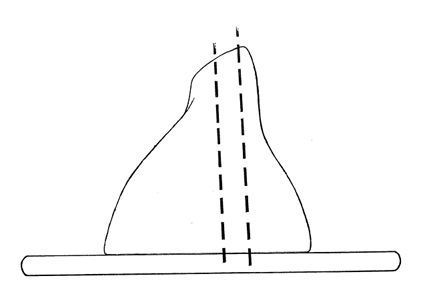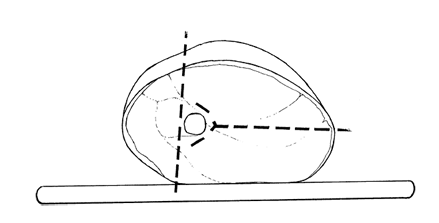The Cook's Illustrated Cookbook (195 page)
Read The Cook's Illustrated Cookbook Online
Authors: The Editors at America's Test Kitchen
Tags: #Cooking

![]() WHY THIS RECIPE WORKS
WHY THIS RECIPE WORKS
We figured cooking a country ham would be pretty straightforward, but a little research proved that there are many different approaches. First we focused on the soaking and cooking method. Soaking a cured ham causes the salty meat to absorb water, thereby softening the ham and preventing excessive dryness. Soaking time depends on how long the ham has aged. Hams aged for fewer than six months don’t need to be soaked; hams aged for six months to a year should be soaked for 36 hours; and hams aged for more than a year should be soaked for three days, with the water being changed every day. As for cooking, we liked simmering, which adds a touch of moisture and makes it easier to remove the ham bone for more convenient serving.
SERVES 30
If using an older ham, scrub mold off with a food-grade scrub brush (such as a vegetable brush), under running water. Not removing the hock from the ham makes for a nicer presentation, but if desired, use a hack saw to remove the hock so that the ham fits more easily into the pot (this can also be done by your butcher). To soak a hock-on ham, we found a large clean cooler to be an ideal soaking vessel.
1 | (14- to 15-pound) country ham |
3 | carrots, cut into large chunks |
3 | celery ribs, cut into large chunks |
2 | onions, cut into large chunks |
6 | sprigs fresh thyme or fresh rosemary |
¹⁄ | cup sorghum or packed brown sugar |
1.
Place ham in stockpot and cover with water. Soak ham, changing water at least daily, to release salt and rehydrate ham, about 36 hours for hams aged 6 to 12 months and 3 days for hams aged over a year.
2.
Bring large kettle of water to boil. Adjust oven rack to lowest position and heat oven to 325 degrees. Drain ham; discard soaking water. Cover bottom of roasting pan with large piece of aluminum foil (foil should be long enough to form tent over ham). Arrange carrots and celery in even layer over foil, tucking onion chunks and thyme in between. Set ham over vegetable bed, fat side up. Place pan in oven. Pour boiling water halfway up pan sides; pull foil around ham, forming loose tent. Bake until thickest part of ham registers 125 to 130 degrees, 2¹⁄
2
to 3 hours.
3.
Remove pan from oven (cool ham slightly, if necessary). Carefully remove skin with knife, leaving ¹⁄
4
-inch layer of fat. Score diamond pattern into fat, if desired, then brush with sorghum. Remove vegetables and cooking liquid from roasting pan, return ham to pan; bake until temperature registers 145 to 150 degrees (depending on desired crispness), 30 minutes to 1 hour longer. Transfer to a carving board. Cool slightly; carve into thin slices and serve.
![]() WHY THIS RECIPE WORKS
WHY THIS RECIPE WORKS
We wanted to develop a recipe for fresh ham worthy of a holiday table, one with moist meat and crackling crisp skin. Since a whole leg is too large for most occasions, we settled on using the shank end (from the bottom of the leg) and scored the fat. Then we brined the ham in a solution flavored with brown sugar, garlic, bay leaves, and black peppercorns. Starting the ham at high heat and finishing at low heat gave us a crisp, flavorful skin and tender meat. We finished our fresh ham with a sweet—but not cloying—glaze.
See “CARVING TWO CUTS OF HAM” illustrations that follow recipe.
SERVES 8 TO 10
If you don’t have room in your refrigerator, you can brine the ham in a large insulated cooler or a small plastic garbage can; add five or six freezer packs to the brine to keep it well cooled.
HAM AND BRINE
1 | (6- to 8-pound) bone-in, skin-on ham, preferably shank end, rinsed |
3 | cups packed brown sugar |
2 | cups salt |
2 | garlic heads, cloves separated, lightly crushed and peeled |
¹⁄ | cup whole black peppercorns, crushed |
10 | bay leaves |
GARLIC AND HERB RUB
1 | cup fresh sage, lightly packed |
¹⁄ | cup fresh parsley |
¹⁄ | cup olive oil |
8 | garlic cloves, peeled |
1¹⁄ | teaspoons salt |
1¹⁄ | teaspoons pepper |
GLAZE
1 | recipe glaze (recipes follow) |
1. FOR THE HAM AND BRINE:
Carefully slice through skin and fat with serrated knife, making 1-inch diamond pattern. Be careful not to cut into meat.
2.
Dissolve sugar and salt in 2 gallons cold water in large container; stir in garlic, peppercorns, and bay leaves. Submerge ham in brine, cover, and refrigerate for 8 to 24 hours.
3.
Set large disposable roasting pan on baking sheet for extra support; place flat wire rack in roasting pan. Remove ham from brine and thoroughly pat dry with paper towels. Place ham, wide cut side down, on rack. (If using sirloin end, place ham skin side up.) Let ham stand, uncovered, at room temperature for 1 hour.
4. FOR THE RUB:
Meanwhile, adjust oven rack to lowest position and heat oven to 500 degrees. Process all rub ingredients in food processor until mixture forms smooth paste, about 30 seconds. Rub all sides of ham with paste.
5.
Roast ham at 500 degrees for 20 minutes. Reduce oven temperature to 350 degrees and continue to roast, brushing ham with glaze every 45 minutes, until ham registers 145 to 150 degrees, about 2¹⁄
2
hours longer.
Transfer to carving board,
tent loosely with aluminum foil, and let rest for 30 to 40 minutes. Carve and serve.
Substitute 6 liters cola for water in brine, omitting sugar and reducing salt to 1¹⁄
2
cups.
MAKES
1¹⁄
2
CUPS, ENOUGH FOR 1 RECIPE
ROAST FRESH HAM
2 | cups packed brown sugar |
1 | cup apple cider |
5 | whole cloves |
Bring sugar, cider, and cloves to boil in small saucepan over high heat; reduce heat to medium-low and simmer until syrupy and reduced to about 1¹⁄
3
cups, 5 to 7 minutes. (Glaze will thicken as it cools between bastings; cook over medium heat about 1 minute, stirring once or twice, before using.)
MAKES ABOUT
1¹⁄
2
CUPS, ENOUGH FOR 1 RECIPE
ROAST FRESH HAM
2 | cups packed brown sugar |
1 | tablespoon grated orange zest plus 1 cup juice (2 oranges) |
4 | star anise pods |
1 | (3-inch) cinnamon stick |
Bring sugar, orange zest and juice, star anise, and cinnamon to boil in small saucepan over high heat; reduce heat to medium-low and simmer until syrupy and reduced to about 1¹⁄
3
cups, 5 to 7 minutes. (Glaze will thicken as it cools between bastings; cook over medium heat about 1 minute, stirring once or twice, before using.)
MAKES
1¹⁄
2
CUPS, ENOUGH FOR 1 RECIPE
ROAST FRESH HAM
2 | cups packed brown sugar |
1 | cup pineapple juice |
1 | tablespoon grated fresh ginger |
1 | tablespoon red pepper flakes |
Bring sugar, pineapple juice, ginger, and pepper flakes to boil in small saucepan over high heat; reduce heat to medium-low and simmer until syrupy and reduced to about 1¹⁄
3
cups, 5 to 7 minutes. (Glaze will thicken as it cools between bastings; cook over medium heat about 1 minute, stirring once or twice, before using.)

SHANK END
1.
Transfer ham to carving board and carve lengthwise alongside bone, following 2 dotted lines in illustration above.

SIRLOIN END
2.
Lay large boneless pieces you have just carved flat on carving board and slice into ¹⁄
2
-inch pieces.
![]() WHY THIS RECIPE WORKS
WHY THIS RECIPE WORKS
Glazed ham is appealingly simple but often comes out dry and jerkylike. We wanted a top-notch glazed ham that is always moist and tender, with a glaze that complements, but doesn’t overwhelm the meat. Bone-in hams that have been spiral-sliced offered the best flavor with the least amount of carving necessary. We found it important to avoid labels that read “ham with water added” as these hams simply didn’t taste as good. Heating the ham to an internal temperature of no higher than 120 degrees was enough to take the chill off without drying it out. Soaking the ham in warm water before heating it and placing it in an oven bag kept it moist and also reduced cooking time. Finally, we determined that it was best to apply the glaze toward the end of cooking and then again once it came out of the oven.
